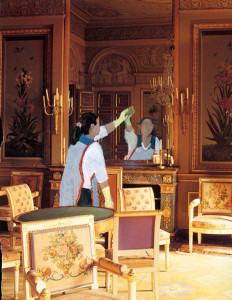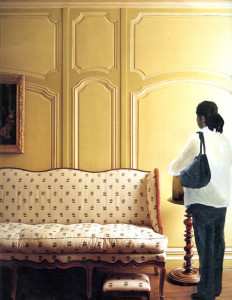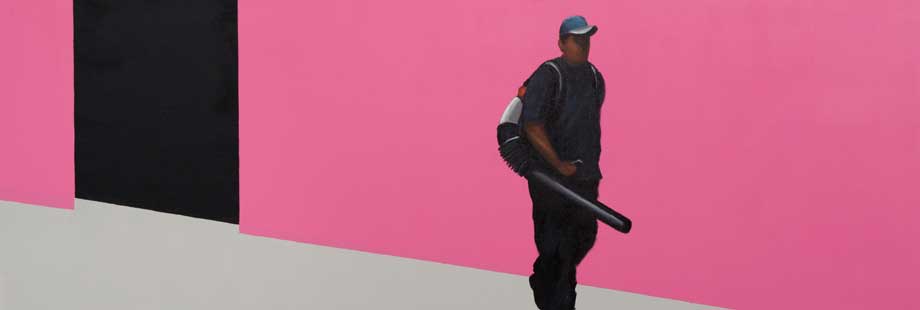While much of the focus on Ramiro Gomez’s new show at Charlie James Gallery, and Gomez’s work generally, has been on labor – as subject and focal point; as a device re-framing public discourse around the subject; as the un- or under-addressed component of its surround or background subject, and a recontextualization of all of these issues – what seems to have gotten lost in the discussion are the larger considerations of visibility and invisibility, appearance and disappearance, implied if not directly addressed in the work. It could almost be argued that the real subtlety and art of the work, inheres in this transitory, what could almost be called sublime, state.
As still and impassive as some of Gomez’s figures present themselves, passage and transition are frequently addressed directly. E.g., a nanny moving decisively with her charge across a room or landscape (or for that matter an art gallery), a gardener pushing a lawn mower, a farm or grocery worker moving a crate of produce; or conversely, receding before a world moving just beyond their (static) domain – as in the line of T-shirted, brown-skinned sewing machine operators arrayed alongside a statuesque (white) model, immaculate and chic in printed skirt and bodice with matching coat stepping out into a big glam glossy Diane von Furstenberg world just out of reach. Trucks and buses reference the cross-town/cross-zone/cross-class trajectory. Then there is the pause – at the edge or in the foreground of a tableau – that seems on the verge of disappearance; the physical dissolve or fade-to-black. (Gomez’s blurred faces and soft contours contribute to this effect.) Or still more poignantly, the oblique reflection in a mirror as the figure moves out of view. One of my favorite pieces in the show was one of the small 8×10 magazine page gouaches with its fragmentary glimpse of a figure moving just beyond a bath and dressing room passage in a spare mirror reflection. (Then, too, there are those reflections of the figure or portrait in full – as the mirror is being polished – with the poignant suggestion of the ambiguous play of attitudes that might unfold in that moment as the subject confronts her reflection.)
 Mirrors or highly polished surfaces figure prominently in a number of these pieces. The world pulled from or evoked by these glossy pages is already pretty glossy – and (naturally) well-maintained. More often than not, it’s also empty. I mean, really empty; emptied out, almost over-edited, of signs of the lives led or intended to be led in these rooms. Gomez’s silhouetted figures make us even more conscious of this vacancy, this unnatural quietude. It’s a frame for glamour somehow bled dry of its electric charge (and charm). They are spaces conceived (not always entirely successfully) as the backdrops for the glamourous evenings, doings, and personalities that will ostensibly fill them. (And we even see hints of the irony that they ultimately won’t.)
Mirrors or highly polished surfaces figure prominently in a number of these pieces. The world pulled from or evoked by these glossy pages is already pretty glossy – and (naturally) well-maintained. More often than not, it’s also empty. I mean, really empty; emptied out, almost over-edited, of signs of the lives led or intended to be led in these rooms. Gomez’s silhouetted figures make us even more conscious of this vacancy, this unnatural quietude. It’s a frame for glamour somehow bled dry of its electric charge (and charm). They are spaces conceived (not always entirely successfully) as the backdrops for the glamourous evenings, doings, and personalities that will ostensibly fill them. (And we even see hints of the irony that they ultimately won’t.)
And of course that glamour depends upon this emptiness, the illusion that it just happens (so it can be carelessly unraveled and chicly untidied – with the unspoken understanding that it will be cleaned up, swept, mopped, and polished the next morning). For the shiny class to shine, the matte class must remain muted and more or less invisible behind the scrim.
Contrary to Lawrence Weschler’s remarks at a conversation with Gomez at the Hammer Museum last Thursday evening, these are not entirely invisible (or transparent – I think the phrase he used was ‘looking right through them’), unseen or unnoticed people (and they’re certainly not unheard, as anyone who’s been within a hundred yards of lawn blower or power hedge trimmer can attest). Certainly they are relegated to the shadows of the main action. The perfection, the glamour of the mise-en-scène depends upon their recession from the scene – behind screens, windows, hedges, truck cabs and paneled vans.
Gomez acknowledges this to the extent that the figures he paints are blurred (though precise and very distinct) silhouettes. Expressions, faces, identities are blurred. The face becomes a mask; but then we’ve seen this phenomenon in life – the frozen expression; the distancing, neutralization; the emotional shutting down. But there is also an insulation, even power, in this kind of anonymity. The employer can take/exploit the worker’s labor, service, maintenance, ‘zhuuzhing’ of this brittle ‘glamour’; but s/he can’t take any part of her/his personality or identity. There is also the wildcard variable in this power equation – the undercurrent of economic volatility that might potentially upend these relationships: the employers are in all likelihood as disposable as the employees. (Still the illusion is powerful – the sense that whatever happens, nothing could intrude upon or disturb these luxe, elegant tableaux. However the identities change, there will always be someone to keep house and garden clean, manicured and camera-ready.)
I asked Gomez at the Hammer event whether he saw these figures to any extent as a part of this symbiosis of glamour, and he seemed to demur, reemphasizing his focus on the significance of labor’s singular appearance in these ‘domestic scenes’ (the title of his book with Weschler). To some extent this seems more apparent in his current show at Charlie James Gallery, On Melrose, where the figures are more definitively asserted against hedges, walls, and that slab of pink that might be a nod to both Ellsworth Kelly and Elsa Schiaparelli, but bears the distinctive Paul Smith signature logo. The reverse is also true, as when a landscape worker pushing a lawn mower seems almost existentially lost in a treeless swath of lawn and dwarfed by the ultramarine façade of the Pacific Design Center (a repository for the kinds of furnishings and décor accessories that fill those luxury/shelter magazines).
Gomez is already a master of gesture, posture, attitude. We see the exploitation writ large and small: a meager check and post-it memo of wage calculation (the casual contempt is almost hilarious) painted onto a surface dominated by a gleaming Rolex watch; the scratch or legal pad notes of cleaning supplies or assigned tasks and errands casually placed over a television script or production schedule (labor’s fungible, utilitarian tasks marginalized against the bourgeois creative agenda); and most eloquently, ineffably, those still moments of uncertainty, anxiety, contemplation, and possibly quiet desperation (or simply exhaustion) as workers pause, take breaks, prepare to leave or wait for their checks. Some of these are almost breathtaking: it’s the limbo where the figures seem on the verge of evaporating, caught between self-abnegation and self-acknowledgment. 
Gomez addresses the notions of both stillness and passage in a series of paintings on canvas (that, as if to parallel his Hockney pastiches, turn a page from Ed Ruscha’s series of Sunset Strip facades), taking us past a series of Melrose Avenue facades and landmarks, from Doheny in West Hollywood/Beverly Hills to Hoover, including the PDC corner of Melrose and La Cienega, Paul Smith, and the Paramount main gate – a route presumably taken by many of the figures depicted in these tableaux en route to less manicured districts in the far eastern or southern reaches of the city. The flatness, hard angles, and quasi-schematic reductiveness (as with the Paul Smith panels) reference hard-edge geometric and minimalist color field abstraction (along Kelly lines – even the car windows, especially the car windows), but the space and emptiness also convey a sense of their ephemerality. This, too, will evaporate and disappear as surely as the scenery flats at Paramount will one day crumble. The brightest stars fade – in L.A. no less than the rest of the cosmos – all of us destined for smoke, ash and dust, and eventually to be swept or polished off another shiny surface in a place beyond reckoning.


